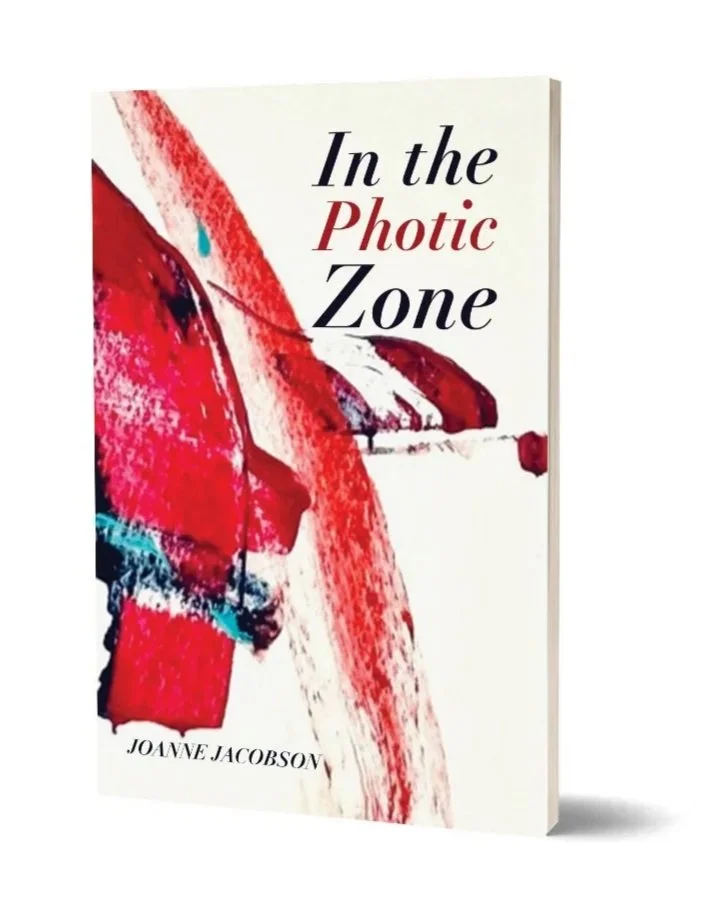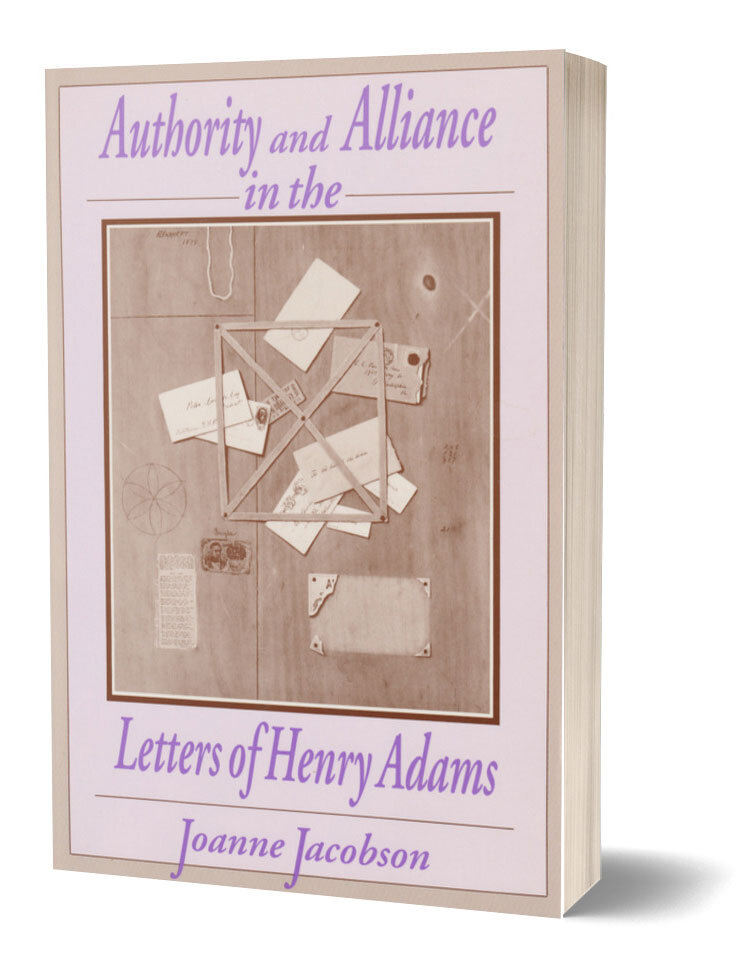FORTHCOMING IN 2026 FROM FINISHING LINE PRESS:
In the Photic Zone (prose chapbook)
“In the Photic Zone is a beautiful book of perilous covered things: the naked razor a grandmother inexplicably carries in her purse, the disease of the blood invisible until it erupts, the unvoiced grief of a father bursting with anger. Descending toward unlit depths, chipping at upper strata, Jacobson is both diver and geologist; in quest of the secrets people take to their graves, she is finally compelled to concede that “Not all concretions contain specimens!”; dreaming she might “empty the world of its secrets,” she gracefully concedes failure. From human limitation and mortality, Jacobson, with the lyricism of a Merwin, the syntactic elegance of Virginia Woolf, and the fervor of her parents’ gardening, cultivates beauty. And we are altered as we read her work: made more human, acutely conscious of our evanescent life on earth, and of the love that can hold off, and finally accompany, death, like a shining stone in a dark place. This book is such a stone.”
— Natania Rosenfeld, Outsiders Together: Virginia and Leonard Woolf, Wild Domestic, and The Blue Bed
“Every single word in this collection illuminates something bright and new about the world. Every story creates constellations. For what hides in our blood, or in the earth, or in our childhoods, or in our deepest relationships, Jacobson finds the language. How can writing be so lyrical and precise at once? This is the work of a master.”
— David Sugarman, Redactions
“In the Photic Zone, Joanne Jacobson’s brilliant new collection, plumbs what we can and cannot easily see into, through, or past. Each of these beautiful, lyric essays explores the disquieting midpoints of the human and natural worlds: the churned up, fossil-filled soil of an abandoned mine; an MRI machine scanning a brain slice by slice; the gardens of cathedrals and internment camps; the bewildering silence in the family car as the drunk father speeds through intersections. In precise, evocative prose, Jacobson sets us squarely down in the center of mystery, insisting that we pay attention to it. It is a breathtaking and perilous space. It will dazzle you.”
— Ann Hudson, Subtraction Isn’t Always Less
Inside In the Photic Zone
The perimeters of my early years: a half-dozen streets unfolding in three directions and then the fourth, work of the final glaciers, Lake Michigan and its beaches. In summer I floated on the great water, shiver-cold until September, stretched nearly to the Canadian border where it reaches its most deep—deeper than life, below the photic zone that marks the limits of photosynthesis.
Every Last Breath: A Memoir of Two Illnesses (University of Utah Press, 2020)
“In this brilliant memoir, so gorgeously written, so richly intelligent, and so achingly heartfelt, Jacobson tells the stories of two illnesses, a mother’s and a daughter’s, one of breath and one of blood. Jacobson plunges all the way down (to borrow from Emily Dickinson) to ‘Where the Meanings are.’ With its lyrical compression and unguarded honesty, Every Last Breath is a knock-out.”
— Richard McCann, author of Mother of Sorrows
Inside Every Last Breath
“My double-scarred neck reveals the fang marks of surgeons’ scalpels seeking the jugular, seeking—to save me—the same route to the heart that any killing animal hopes to open. Southeast Asia’s Hmong tribes honor the epileptic, shaken free of the ordinary, as a seer. I too have been seized by a great force, brought into the presence of pounding uncertainties. Twice already my disease has taken me to the brink, where the creaky workings of life are laid bare and forced into the light—at once sweet and bitter, unwelcome and amazing. Like a raven my disease takes flight, taking me—taking me with him. He scares me, he enthralls me, he grips tight my attention, he takes me on a wild ride to a place where I cannot count on surviving. I cry out, I growl, I claw my way back to life, strangely renewed. Wings dark as night, eyes bright as stars, my most intimate enemy and my most inscrutable companion, he comes back for me again and again.”
Hunger Artist: A Suburban Memoir (Bottom Dog Press, 2007)
“Hunger Artist is an extraordinary accomplishment—a book that reveals the national imaginary of postwar America through the intimate details of one girl’s life in the Chicago suburbs. The hopes and anxieties of the period, the dynamics of generation, gender and ethnicity are all uncovered in this gem of a memoir. Joanne Jacobson’s intertwining of a young girl’s life and a culture’s history is simply beautiful and unforgettable.”
— Julie D’Acci, University of Wisconsin—Madison
Inside Hunger Artist
“In late August or early September as we played softball, a dull sound began to gather in the field like static, softer than wind, as though the dial on a far-off transistor radio was being gently turned. We looked up and shivered: between us and the high sun a thin cloud was moving in, rolling in low waves. At the edges, dark motes flashed. We paused and stood, watching and listening—not quite afraid but aware of the mysterious presence that had come close to each one of us, moving as we breathed and as our hearts beat in the dimmed light and the soughing air. As the cloud passed, frantic objects became caught in the high mesh backstop and slid, stunned, to the ground where we found them: monarch butterflies stilled on their long annual migration south from Canada to Mexico. The velvet legs twitched when we touched them, the orange and black wings, tinsel-thin, beat with fear in our clumsy, cupped hands, slowly weakening before we realized—too late—what fragile glory we held, already fading in the last of the summer sun.”
Authority and Alliance in the Letters of Henry Adams (University of Wisconsin Press, 1992)
“No reader of Jacobson’s work will ever again approach letters by literary figures in the same way.”
— Cecelia Tichi, Vanderbilt University
Inside Authority and Alliance in the Letters of Henry Adams
“Threatened with isolation, Adams chose alliance. Threatened with closure, Adams chose resistance. Threatened with silence, Adams chose speech. Faced with each of these threats, Adams also chose letters, because they enabled him to occupy rhetorical ground over which he could retain control. Adams’s enduring commitment to ‘writing a good many letters’ testifies to his refusal to abandon either resistance or alliance as weapons against alienation, even as he recognized in alienation an important source of his authority as a writer and of strategies of collaboration. If Henry Adams’s letters implicate the form in the consolidation of elite cultural control in the United States at the turn of the century, they also demonstrate the letter’s ability to speak with strategic force from the margins, where authority and alliance remain continually negotiable.”



